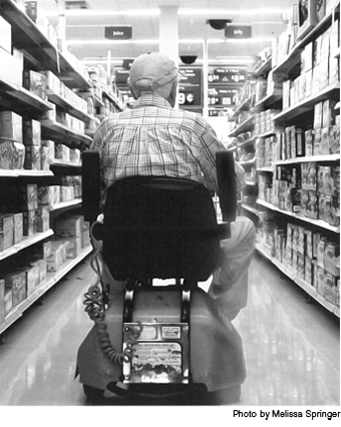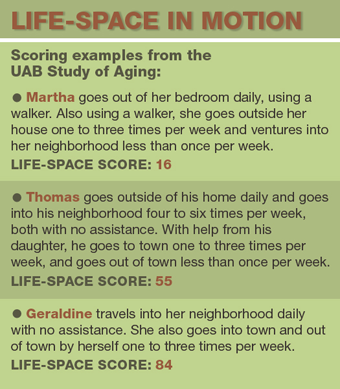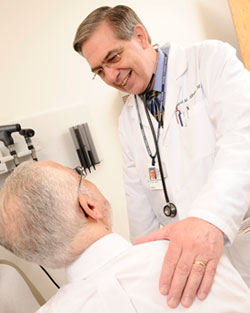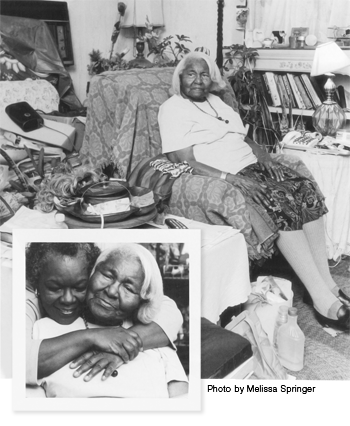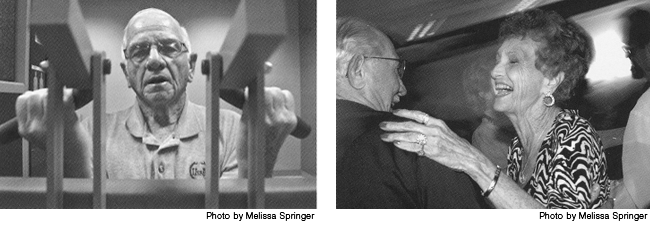Insights on Action From UAB’s Study of AgingBy Bob Shepard
In our increasingly mobile society, the fastest-growing segment of the population is also the slowest moving: Over the next few decades, the number of people in the United States over age 65 will double. But a major UAB study has demonstrated that mobility is just as important to older Americans as it is to their younger counterparts. In fact, for the elderly, the ability to keep moving can mean the difference between life and death. The UAB Study of Aging enrolled a thousand people in five central Alabama counties and followed them for eight years. Over that time, participants who frequently ventured out beyond their homes, without assistance from equipment or another person, were far more likely to remain healthy and independent than those who stayed at home or left only with assistance, says Richard Allman, M.D., principal investigator of the Study of Aging and director of the Birmingham/Atlanta VA Geriatric Research, Education, and Clinical Center and the UAB Center for Aging. Allman compares the Study of Aging to the famous Framingham Heart Study, which began in 1948 and has provided much of the now common knowledge on the effects of diet, exercise, and medications on heart disease. In the same way, Allman says, UAB's study is “providing the knowledge that will be needed to develop and validate a whole host of possible interventions aimed at giving our aging population a better quality of life.” Marks for MovementThe key contribution of the Study of Aging is a concept called life-space. While the traditional method of measuring mobility is to judge a person’s ability to walk, UAB researchers have used the study’s findings to develop and test this far more flexible assessment tool. In essence, life-space is an objective measurement of a person's ability to function and participate in society. And it is already proving to be an invaluable part of the search for new ways to improve the health of older Americans, Allman says. The UAB Study of Aging Life-Space Assessment measures mobility during the previous month in five different locations or life-space zones: the home, outside the home, the neighborhood, the town, and beyond. Scoring is based on how often a person leaves each of these areas, how frequently they leave, and whether they have assistance when they do leave; scores range from 0 to 120. An older person who only leaves her house for doctor visits, and requires assistance to do so, will score lower than a person who drives himself to the golf course three times per week and goes out to eat on the weekend. (See “Life-Space in Motion.”)
A Powerful ToolAllman says UAB research has shown that a low life-space score is a good predictor of mortality and nursing-home admission, while “higher life-space scores correlate with more independent function and more freedom.” More than 65 percent of subjects with a life-space score of 30 or less died during the course of the Study of Aging, as opposed to only 19 percent of those with a score of 90 or above. Sixteen percent of subjects with scores under 30 ended up in a nursing facility, while for those scoring more than 90, the rate was only 3.5 percent. That makes life-space a powerful tool for geriatricians as they try to identify the most important factors affecting a person's ability to function independently, Allman says. “We found that life-space decline can be accelerated by any number of factors, such as having more than one medical illness or condition, by unintended weight loss, or by smoking,” he explains. “This gives us targets for strategies to counter the decline—by aggressively combating weight loss during hospitalization, for example, and by promoting smoking cessation and physical activity. Life-space tells us where to concentrate our resources for the best results. And if an intervention helps to keep life-space scores high, or prevents their decline, we know that it is working.” Isolating Interventions
UAB researchers are now planning to identify the biggest threats to life-space—and the most effective interventions to combat those threats—with the launch of the Study of Aging II. The original investigations were funded by two five-year grants from the National Institute on Aging (NIA); a new five-year NIA grant will support the follow-up study. Allman says researchers will focus on defining the frequency and magnitude of life-space changes associated with events such as a new cancer diagnosis, bereavement, or giving up driving. They also will examine interventions that can address risk factors for life-space decline, such as the availability of transportation, nutritional status, smoking, and amount of physical activity. A third area of focus will involve additional investigations into the reasons for racial disparities in life-space noted during the Study of Aging. “Life-space really reflects an individual's participation in life,” Allman says. “That concept is going to be more and more valuable as we use it to dig even deeper into how we help people continue to live meaningful lives.”
|
